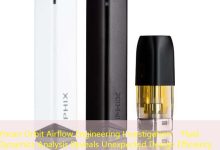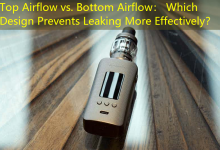Inferior vs.. Fluxo de ar superior: Como a posição da entrada de ar afeta a qualidade do vapor?
Muitos entusiastas da vaporização sabem que o fluxo de ar desempenha um papel crítico na produção e qualidade do vapor. No entanto, o que muitos não percebem é como a posição da entrada de ar – especificamente o fluxo de ar inferior versus superior – pode impactar significativamente a experiência geral de vaporização. This article will delve into the nuances between
bottom airflow
e
top airflow
sistemas, examinando como suas configurações afetam a qualidade do vapor, sabor, e satisfação do usuário.

Compreendendo o fluxo de ar: O Básico
Airflow in vaping devices is responsible for delivering the air necessary to vaporize e-liquid. A posição da entrada – seja na parte inferior ou superior – pode alterar a forma como esse ar interage com a saída de vapor e sabor. Os principais fatores incluem turbulência, resfriamento, and flavor concentration. Bottom airflow tends to produce more vivid flavors, while top airflow can lead to smoother hits.
The Case for Bottom Airflow
Bottom airflow systems draw air from below the coil, leading to several distinct characteristics:
- Enhanced Flavor: By pulling air directly over the heated coil, bottom airflow systems can deliver a more concentrated flavor.
- Vapor Density: The airflow directly hitting the coil results in denser vapor due to efficient vaporization.
- Direct Contact: The airflow allows for a more immediate interaction with the e-liquid, enhancing overall sensation.
No entanto, users might notice that bottom airflow can sometimes produce a warmer vaping experience, which could be uncomfortable for some. Por exemplo, a popular tank like the GeekVape Zeus RTA utilizes bottom airflow, allowing for robust flavor and dense clouds, appealing to flavor chasers.
Benefits of Top Airflow Systems
Por outro lado, top airflow setups introduce air from above the coil, offering a different set of advantages:
- Smoother Hits: The air has a chance to cool down as it travels down towards the coil, resulting in less throat hit.
- Lesser Leakage: With the airflow positioned at the top, these devices are generally less prone to leaking, making them user-friendly.
- Versatile Build Options: Many top airflow devices accommodate different coil configurations, allowing users to experiment with various setups.
An excellent example of top airflow performance can be found in the SMOK TFV12 Prince Tank. This tank provides smooth airflow and produces soft, flavorful vapor that many users prefer for longer sessions.
Vapor Quality Comparisons
| Recurso | Fluxo de ar inferior | Fluxo de ar superior |
|---|---|---|
| Intensidade de sabor | Alto | Moderate |
| Vapor Density | Dense | Light |
| Cooling Effect | Minimal | Alto |
| Leakage Risk | Higher | Lower |
User Preferences and Recommendations
The choice between bottom and top airflow largely comes down to personal preference. For those who prioritize intense flavor and vapor density, bottom airflow systems are highly recommended. No entanto, if you prefer smooth, easy draws and greater convenience, top airflow configurations may be more suitable. Manufacturers today recognize this split in preferences and often design devices that incorporate both airflow options, allowing users to customize their experience.
Em última análise, understanding the impact of airflow on vapor quality can enhance one’s overall vaping experience. Whether you lean towards a
bottom airflow
setup for flavor or a
top airflow
option for a smoother experience, each configuration offers its unique benefits tailored to varying vaping styles.







